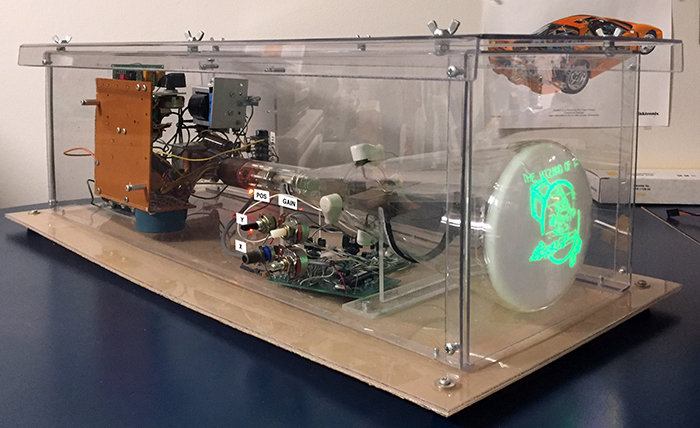This exhibit is a demonstration a a simple cathode ray tube – a CRT. It was one of the first commercially-available CRTs produced by RCA in the mid-1930s – and it still works! The term “cathode ray” was created in the early 1900s for the emission of unknown composition discovered to come from experimental vacuum tubes. Cathode rays were eventually determined to be a stream of electrons, but the name stuck.
This CRT has three primary constituents:
- A vacuum bottle or envelope which were often made from glass as with this CRT, but at Tektronix most CRT funnels were made from ceramic produced in this building 13. The primary purpose of the enclosure is to the maintain the high vacuum inside which is required for the tube’s operation. The vacuum in the tube is comparable to that of outer space.
- The second component in the CRT is the electron gun composed of a cathode, a structure with the unique capability of ejecting free electrons into the tube’s vacuum. The cloud of electrons created at the cathode in the back of the gun is shaped into a pencil-like beam, focused and accelerated toward the screen. The plates at the front of the gun deflect the beam horizontally and vertically, under the influence of the drive electronics, to create the image you see on the screen. Electrons have a negative charge so they’re attracted by a positive voltage on the plates and repelled by a negative voltage. For example, by adjusting the vertical deflection control on the side of the demonstration box with the appropriate voltage, the scan is moved up or down. You can also deflect the beam with the poles of a magnet’s field (demonstrate). Some CRTs used magnetic coils to deflect the beam.
- The third component of the CRT is the phosphor screen. Phosphors are specialized materials, usually applied as a powder, that emit light under the influence of an energy source. In this case, the kinetic energy of the fast-moving electron beam is exciting the phosphor and causing it to glow where the beam strikes it. Phosphors are available with many emission colors but green was often used in CRTs because the human has the greatest sensitivity for that part of the visible spectrum. Phosphors are used today in fluorescent lamps and in white LEDs.
Cathode ray tubes were used in every Tektronix oscilloscope up into the 1990s and all television sets for the first fifty or so years of their existence. Today, CRTs have almost completely been replaced by flat panel displays, primarily liquid crystal panels.
Visitors can view inside this CRT to view the internal construction. Magnets are available to demonstrate the deflection of the electron beam and resulting image on the screen.
We also have a video of the construction of our Early CRT Exhibit on our Video Gallery.

